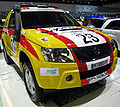2007 Suzuki Grand Vitara Owner's Manual - Page 169
2007 Suzuki Grand Vitara Manual
Page 169 highlights
INSPECTION AND MAINTENANCE Uniform Tire Quality Grading WARNING Replacing the wheels and tires equipped on your vehicle with certain combinations of aftermarket wheels and tires can significantly change the steering and handling characteristics of your vehicle. Oversized tires may also rub against the fender over bumps, causing vehicle damage or tire failure. Therefore, use only those wheel and tire combinations approved by SUZUKI Motor Corporation as standard or optional equipment for your vehicle. For information regarding the specified tires, refer to the Tire Information Label located on the driver's side door pillar or the "SPECIFICATIONS" section. The U.S. National Highway Traffic Safety Administration has developed a grading system for evaluating the performance of passenger car tires. The following information will help you understand the grading system, which applies to vehicles sold in the U.S. Consult your SUZUKI dealer or tire retailer for help in choosing the correct replacement tires for your vehicle. Quality grades can be found where applicable on the tire sidewall between tread shoulder and maximum section width. For example: Treadwear 200 Traction AA Temperature A the norm due to variations in driving habits, service practices and differences in road characteristics and climate. Traction - AA, A, B, C The traction grades, from highest to lowest, are AA, A, B and C. Those grades represent the tire's ability to stop on wet pavement as measured under controlled conditions on specified government test surfaces of asphalt and concrete. A tire marked C may have poor traction performance. WARNING The traction grade assigned to this tire is based on straight-ahead braking traction tests, and does not include acceleration, cornering, hydroplaning or peak traction characteristics. Temperature - A, B, C The temperature grades are A (the highest), B and C, representing the tire's resistance to the generation of heat and its ability to dissipate heat when tested under controlled conditions on a specified indoor laboratory test wheel. Sustained high temperature can cause the material of the tire to degenerate and reduce tire life, and excessive temperature can lead to sudden tire failure. The grade C corresponds to a level of performance which all passenger car tires must meet under the Federal DOT Quality Grades Treadwear Traction AA A B C Temperature A B C All Passenger Car Tires Must Conform To Federal Safety Requirements in Addition To These Grades Treadwear The treadwear grade is a comparative rating based on the wear rate of the tire when tested under controlled conditions on a specified government test course. For example, a tire graded 150 would wear one and one-half (1 1/2) times as well on the government course as a tire graded 100. The relative performance of tires depends upon the actual conditions of their use, however and may depart significantly from CAUTION Replacing the original tires with tires of a different size may result in false speedometer or odometer readings. Check with your SUZUKI dealer before purchasing replacement tires that differ in size from the original tires. 9-28
















